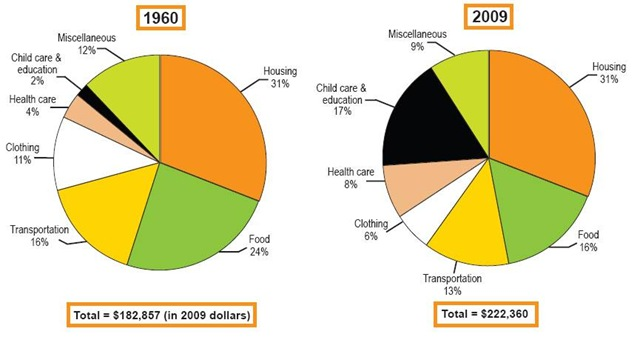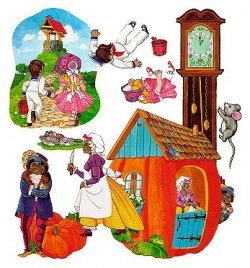
UNIT I: EDUCATION IN THE USA
Focus I. Pre-School Years
A CTIVE
LISTENING
CTIVE
LISTENING
Before Listening Activities
Activity I: Orientation
Who takes care of young children (up to the age of five) in Russia? Do you know how much parents have to pay for childcare?
Look at the pie charts comparing the expenses on children (from birth through age 17) in 1960 and 2009. Describe the charts using the vocabulary below. Summarize the trends. Can you explain them?

(http://www.wealthinformatics.com/2010/09/27/cost-of-raising-a-child/)
Vocabulary: Describing the changes
Verbs and adverbs: to increase/rise by, to decrease/fall by, to increase/go up/climb/rise to, to decrease/fall/decline/drop/go down/reduce to, to maintain the same level, to remain steady/stable (at), to fluctuate around, to grow (rise, fall, etc) dramatically/ sharply/considerably/significantly/slightly
Nouns and adjectives: a slight/dramatic/sharp/gradual/steady/substantial/significant increase (rise, growth, decrease, decline, fall, etc)
Activity II: Helpful Vocabulary
1. Look at the list of words used to describe various childcare providers in the USA. Match the words to their definitions.
1) au pair |
a) a school or class to prepare children aged five for school |
2) babysitter |
b) care provided by an individual or a few individuals in their private home |
3) daycare center |
c) a school for children between the ages of about two and five |
4) home daycare |
d) a place when babies or young children are looked after during the day, especially while their family members are at work |
5) Head Start center |
e) a facility where care for a parent’s baby or toddler is provided either directly at her/his place of employment or directly adjacent to it |
6) kindergarten |
f) a person who takes care of babies or children while their parents are away from home and is usually paid to do this |
7) nanny |
g) a parent who stays at home to take care of their children instead of going out to work |
8) on-site (corporate) daycare center |
i) a woman whose job is to take care of young children in the children’s own home |
9) preschool (nursery school) |
j) a young person, usually a woman, who lives with a family in a foreign country in order to learn the language. She/he helps in the house, takes care of children and receives a small wage |
10) stay-at-home mother/father |
k) a federally-funded center for children aged three to five years from low-income families. Its aim is to prepare children for success in school through an early learning program. |
2. Put the words from the previous exercise into the following categories:
center-based care (facilities which provide care for children in groups)
family childcare (providers who offer care for children in their own home)
in-home care (care occurs in the child’s own home)
Guess the meaning of the underlined words and phrases from the context:
The daycare dilemma is always on my mind. It’s just always there. It’s pervasive.
When my friends needed to make the decision whether or not to go back to work, they sat down and calculated out to the nth expense.
Many daycare centers are expensive, they are places where parents are overcharged.
I grew up in an area where all my relatives lived. It was a built-in unit.
If one of the parents was busy, you were dropped at aunt’s house, uncle’s house.
You cannot underestimate having a grandmother. It’s one of the greatest inventions ever.
Who did you think might take care of your child, and how does it match up with what actually happened?
When I found out I was pregnant, I definitely went through sticker shock.
Listening Comprehension Activities
1. You are going to hear a discussion which takes place in a radio station studio. The radio host Michelle Norris is talking with a group of parents from Washington, D.C. about childcare costs in the USA. The participants of the discussion are:
Stacy Ferguson, who has had different kinds of childcare for her three kids
Sharon Johnson, a retired woman who takes care of her three-year-old grandson while his parents work
Adam Graham, a former stay-at-home dad who has two daughters
Kelly Hruska, a stay-at-home mother of two small girls
Angela Tilghman, a single mother who works long hours while a lifelong friend cares for her special needs son
Listen to the discussion and write T (true) or F (false) in front of each of the sentences below. Correct the false statements.
The participants of the discussion believe that childcare providers make a lot of money as daycare expenses are quite big.
Adam says that he paid for his daughter’s Montessori school more than for his own college education.
Sharon insisted that her daughter and her son-in-law pay her for taking care of their child because she needed additional income.
Sharon would like to open a center to provide affordable childcare.
Nannies in D.C. cost about thirty - forty thousand dollars per year.
Stacy regrets that she stayed at home for the first years of her child’s life instead of going back to work and making a career.
Angela was at a loss when she found out that she was pregnant.
2. Listen again and answer the following questions:
What does Kelly say about the process of making the decision whether to go back to work or become a stay-at-home parent?
How does Sharon describe her experience as a nanny for her grandson? What is it like? How much money does she get paid?
What does Adam say about problems his wife and he faced when they had their children? Who helped them to raise their kids?
What does Stacy advise young mothers and mothers-to-be?
In Adam’s opinion, what personal quality is essential for parents?
After Listening Activities
Activity I: Discussing the Issues
1. Study the following chart which compares costs of different types of childcare in the USA. Which is the most affordable option for parents? Which is the most expensive?
Type of childcare |
Average cost for full-time care |
Daycare center |
$380 to $1564 a month for babies and toddlers (average $972) |
Home daycare |
$300 to $1000 a month for babies and toddlers (average $650), $315 to $956 a month for preschoolers (average $636) |
Nanny |
$500 to $700 a week ($2,167 to $3,033 a month); live-in nannies usually receive a bit less |
Relative care |
Often free, but if parents choose to pay, it is usually minimum wage or more. They can also offer to do chores, give gift certificates, or pay an occasional bill for a relative caregiver. |
Stay-at-home parent |
No extra cost — but income drops if you were working before |
Au pair |
an average cost of about $350 a week for full-time live-in care |
Babysitter |
an average of $10 per hour |
Note: Costs are based on the latest figures from the National Association of Child Care Resource and Referral Agencies (NACCRRA) (http://www.babycenter.com/childcare-options)
Can you think of pros and cons of types of childcare given in the chart above? Choose one type and discuss your ideas with a partner, then present them to your class. You can use the following stories for some ideas (one story about each type):
1) These young girls can only work 45 hours a week. They must go to school while they’re here. And the host family must pay for them to go to school: $500. So if you’re working full time, you need more help than 45 hours a week. And they don’t really want to work on the weekends. If you need help on the weekends, they’re not going to work on the weekends (http://www.npr.org/templates/story/).
2) Well, if we talk about nannies, it’s not inexpensive. It is not for everybody. Of course, I think it’s the best option. You have one-on-one care. You have to have references here that we can call. Everybody’s legal. Everybody drives. You are paying more, but you get a lot more bang for your buck (http://www.npr.org/templates/story/story.php?storyId=14151163).
3) My parents have always taken care of my son. I have phobia against bringing anyone into the house that I don’t know and that’s not related to me, who may hurt him, like take advantage of him, even. I mean, just every headline that makes it onto CNN and fills our tabloids is exactly what sits in my head (http://www.npr.org/templates/story/story.php?storyId=14151163).
4) I had a daycare center experience. And I guess the pro of that it’s affordable. But it’s not for somebody who has very flexible hours. Well, I mean, you have to pick up that child by 6 o'clock, come hell or high water. So if you have to work late, that's just way too bad (http://www.npr.org/templates/story)
5) While I loved the in-home provider and she was much cheaper, either she or her kids were constantly sick, so she was constantly closing. It became a huge problem for me and my husband. She closed for two weeks once and we had to scramble to find someone to watch our daughter (http://www.circleofmoms.com/working-mums/in-home-daycare-vs-child-daycare-center-553341).
6) When I was kid, my parents hired really good babysitters. I remember one girl in particular who let us watch as much Star Wars as we wanted. Awesome. Another babysitter was this older kid who set up wrestling rings in our basement. My brother particularly appreciated his child-tending “skills”
(http://www.whattoexpect.com/blogs/momonpurposecrazybyaccident/apparently-good-babysitters-are-worth-their-weight-in-gold).
7) I am a stay at home mother, and a qualified teacher. My husband prefers me to be at home with our daughter. He thinks that it is ultimately better for her to be raised by me. I honestly have to agree with him, and THAT is why I am staying at home. We want to be the ones to see her first steps, her first crawl, hear her first words… not a stranger. We trust each other more than I would ever trust a stranger to take care of her (http://www.dumpyourwifenow.com/2007/01/04/are-stay-at-home-mothers-killing-american-men/).
3. If you had young children, which of the childcare options would you choose? Why?

Active Reading
Read for general information on the topic. Write out the words and expressions which seem to be the most relevant to speak about the topic.
Pre-School Education in the USA
Attendance at school for children under six isn’t compulsory, and the provision of schools for children under six varies according to the finances and circumstances of local communities. Most public elementary schools provide a pre-school kindergarten (K) year for five-year-olds, which is usually the first year of elementary school.
There are various types of pre-schools, including non-profit co-operative schools, church-affiliated schools, private schools and Montessori schools. A co-operative school is usually the least expensive, as parents work voluntarily as teachers’ aides alongside professional teachers. Church-affiliated schools are usually attached to religious centers and may include religious education. Private nursery schools are the most expensive – fees range from $5,000 to $15,000 per year for full-time schooling, depending on the school and area. Private schools vary considerably from small home-run set-ups to large custom-built schools. A number of private nursery schools use the Montessori method of teaching, developed by Dr Maria Montessori in the early 1900s. This method is based on the belief that each child is an individual with unique needs, interests and patterns of growth.
Many areas also have what are termed ‘toddler’ or ‘tot’ programs, which usually accept children from two to four years of age. Activities generally include arts and crafts, music, educational games, perceptual motor activities and listening skills. Most communities also have informal community schools or learning centers, playgroups, morning programs at local YWCAs, and other inexpensive alternatives to private schools. Community colleges also offer a variety of courses for small children, e.g. painting, dancing and cooking, once or twice a week, e.g. on Saturday mornings.
(abridged from Living and Working in America, http://www.justlanded.com/english/USA/USA-Guide/Education/Pre-school-education).
C ULTURE
CORNER
ULTURE
CORNER
Getting an Insight into American Culture
Nursery Rhymes
O

Read the following famous nursery rhymes. Do you like them? Why do you think such rhymes can be beneficial for children?
Humpty Dumpty
Humpty Dumpty sat on a wall. Humpty Dumpty had a great fall. All the king’s horses
and all the king’s men Couldn’t put Humpty together again!
(http://americanfolklore.net/folklore/2010/07
There was a crooked man There was a crooked man,
and he walked a crooked mile. He found a crooked sixpence
against a crooked stile. He had a crooked cat
which caught a crooked mouse And they all lived together
in a little crooked house.
Read the translations of the rhymes into Russian. Did you know that these rhymes which are well-known in Russia were translated from English? What rhymes and stories did your parents read to you when you were a child?
Шалтай-Болтай Шалтай-Болтай Сидел на стене. Шалтай-Болтай Свалился во сне. Вся королевская конница, Вся королевская рать Не может Шалтая, Не может Болтая, Шалтая-Болтая, Болтая-Шалтая, Шалтая-Болтая собрать! (пер. С.Я. Маршака) http://www.ekamama.ru/matter/family/12905.html)
|
Жил на свете человек Жил на свете человек, Скрюченные ножки, И гулял он целый век По скрюченной дорожке. А за скрюченной рекой В скрюченном домишке Жили летом и зимой Скрюченные мышки. И стояли у ворот Скрюченные елки, Там гуляли без забот Скрюченные волки. И была у них одна Скрюченная кошка И мяукала она, Сидя у окошка. (Перевод К. И. Чуковского) http://www.ekamama.ru/matter/family/12905.html) |
3. Listen to one more nursery rhyme (a traditional lullaby). Then translate it into Russian.
Mama’s Gonna Buy You a Mockingbird Hush, little baby, don’t say a word, Mama’s gonna buy you a mockingbird. If that mockingbird don’t sing, Mama’s gonna buy you a diamond ring. If that diamond ring turns to brass, Mama’s gonna buy you a looking glass. If that looking glass gets broke, Mama’s gonna buy you a billy-goat. If that billy-goat won’t pull, Mama’s gonna buy you a cart and bull. If that cart and bull turn over, Mama’s gonna buy you a dog named Rover. If that dog named Rover won’t bark, Mama’s gonna buy you a horse and cart. If that horse and cart falls down, You’ll still be the sweetest little baby in town.
(http://www.mamalisa.com/?t=es&p=1443&c=23)

